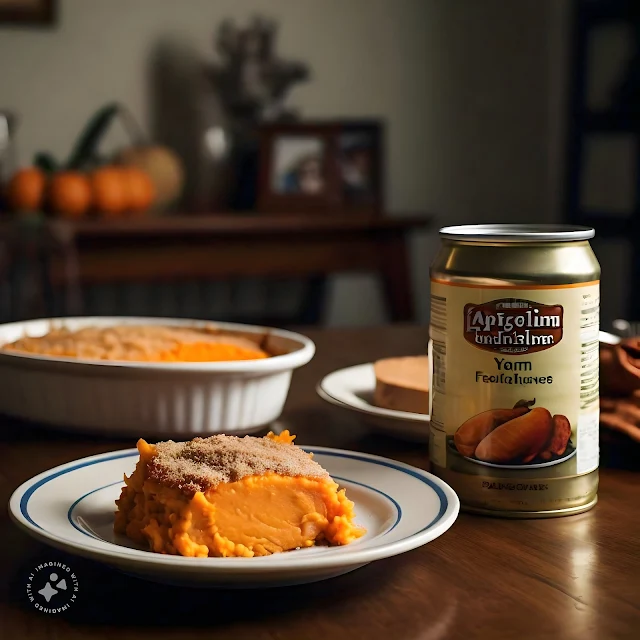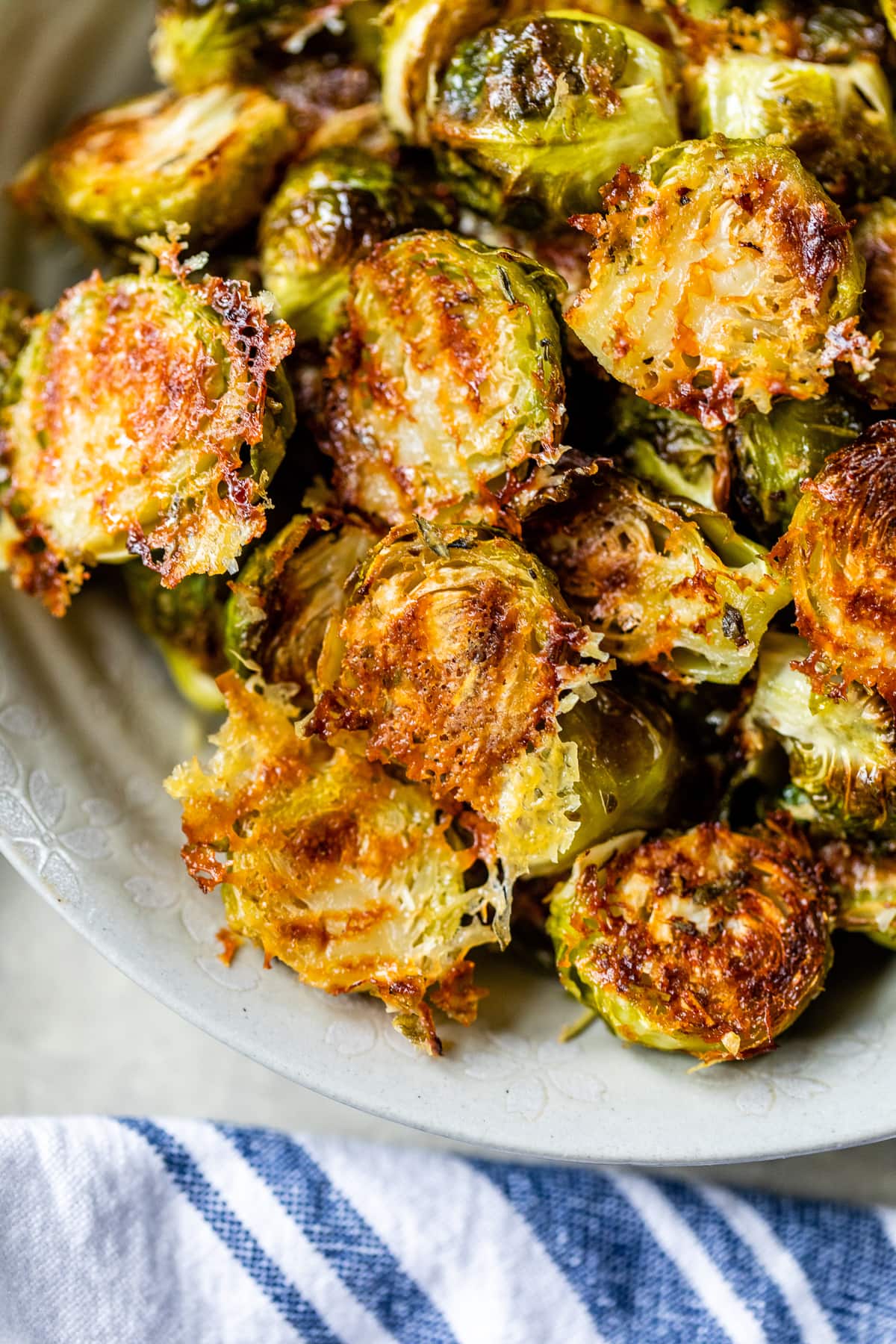Hints:
Old fashioned potato soup recipe | How long to bake a sweet potato | How long to microwave a potato | How long to bake a potato | Sweet potato casserole recipe easy | Sweet potato casserole | Sweet potato soup recipe | How to reheat sweet potato casserole | How long is sweet potato casserole good for | Sweet potato casserole with canned yams
Sweet potato casserole with canned yams
 |
| Sweet potato casserole with canned yams |
Ingredients:- 2 cans (15 ounces each) of yams or sweet potatoes, drained
- 1/4 cup unsalted butter, melted
- 1/4 cup brown sugar
- 1/4 cup maple syrup
- 1 teaspoon vanilla extract
- 1/2 teaspoon ground cinnamon
- 1/4 teaspoon ground nutmeg
- 1/4 teaspoon salt
- 1/2 cup milk (you can use regular milk, almond milk, or any milk substitute)
- 2 eggs, beaten
For the topping:
- 1/2 cup brown sugar
- 1/4 cup all-purpose flour
- 1/4 cup unsalted butter, melted
- 1 cup chopped pecans or walnuts (optional)
Instructions:
1. Preheat your oven to 350°F (175°C). Grease a 9x9 inch baking dish.
2. In a large mixing bowl, mash the drained yams or sweet potatoes with a potato masher or fork until smooth.
3. Add melted butter, brown sugar, maple syrup, vanilla extract, cinnamon, nutmeg, salt, milk, and beaten eggs to the mashed sweet potatoes. Mix until well combined.
4. Pour the sweet potato mixture into the prepared baking dish, spreading it out evenly.
5. In a separate bowl, mix together the brown sugar, flour, melted butter, and chopped nuts (if using) until crumbly. Sprinkle this mixture evenly over the sweet potato mixture in the baking dish.
6. Place the casserole in the preheated oven and bake for 25-30 minutes, or until the topping is golden brown and the casserole is set.
7. Once done, remove from the oven and let it cool for a few minutes before serving.
How long is sweet potato casserole good for
 |
| How long is sweet potato casserole good for |
Sweet potato casserole can generally be stored in the refrigerator for 3-5 days. Make sure to store it in an airtight container to keep it fresh. If you have leftovers, you can also freeze the casserole for longer storage. When properly stored in the freezer, sweet potato casserole can last for 1-2 months. Just be sure to thaw it in the refrigerator before reheating.
How to reheat sweet potato casserole
Reheating sweet potato casserole is pretty straightforward. Here’s a simple guide:
1. Preheat your oven: Set your oven to around 350°F (175°C). This temperature ensures even reheating without burning the edges or drying out the casserole.
2. Transfer the casserole: Place your sweet potato casserole into an oven-safe dish if it’s not already in one. It’s best to avoid using plastic containers or containers that aren’t oven-safe.
3. Cover the dish: Use aluminum foil to cover the casserole dish. This helps to keep the moisture in and prevents the top from becoming too crispy or dry.
4. Reheat: Place the covered dish in the preheated oven and let it heat for about 20-30 minutes. The exact time may vary depending on the size and thickness of your casserole. You can check on it occasionally to ensure it’s heating evenly.
5. Check the temperature: To make sure it's thoroughly heated, you can use a food thermometer. The internal temperature should reach 165°F (74°C) to ensure it’s safe to eat.
6. Serve: Once heated through, carefully remove the dish from the oven and let it cool for a few minutes before serving.
Alternatively, if you’re short on time, you can also reheat individual portions in the microwave. Just make sure to cover the portion with a damp paper towel to prevent it from drying out. Heat in 30-second intervals until warmed through.
Sweet potato soup recipe
 |
| Sweet potato soup recipe |
Here's a simple recipe for sweet potato soup:
Ingredients:
- 2 large sweet potatoes, peeled and diced
- 1 onion, diced
- 2 cloves garlic, minced
- 4 cups vegetable or chicken broth
- 1 teaspoon ground cumin
- 1/2 teaspoon ground cinnamon
- 1/4 teaspoon ground nutmeg
- Salt and pepper to taste
- Olive oil for sautéing
- Optional toppings: chopped cilantro, Greek yogurt, roasted pumpkin seeds
Instructions:
1. Heat a drizzle of olive oil in a large pot over medium heat. Add the diced onion and cook until translucent, about 5 minutes.
2. Add the minced garlic to the pot and cook for another minute until fragrant.
3. Add the diced sweet potatoes to the pot along with the ground cumin, ground cinnamon, and ground nutmeg. Stir to coat the sweet potatoes in the spices.
4. Pour in the vegetable or chicken broth, ensuring that the sweet potatoes are fully submerged. Bring the mixture to a boil, then reduce the heat to low and let it simmer, covered, for about 15-20 minutes or until the sweet potatoes are tender.
5. Once the sweet potatoes are soft, use an immersion blender to puree the soup until smooth. Alternatively, you can transfer the soup in batches to a blender and blend until smooth, then return it to the pot.
6. Season the soup with salt and pepper to taste, adjusting the seasonings as needed.
7. Serve the sweet potato soup hot, garnished with your choice of toppings such as chopped cilantro, a dollop of Greek yogurt, or roasted pumpkin seeds.
Enjoy your delicious and comforting sweet potato soup!
Sweet potato casserole
 |
| Sweet potato casserole |
Ingredients:
For the sweet potato base:
- 4-5 medium sweet potatoes, cooked and mashed
- 1/2 cup granulated sugar
- 1/4 cup butter, melted
- 2 eggs, beaten
- 1/2 cup milk (you can also use evaporated milk for a richer taste)
- 1 teaspoon vanilla extract
For the topping:
- 1/2 cup brown sugar, packed
- 1/3 cup all-purpose flour
- 1/3 cup butter, melted
- 1 cup chopped pecans or walnuts (optional)
- Mini marshmallows (optional, for topping)
Instructions:
1. Preheat your oven to 350°F (175°C) and grease a baking dish (9x13 inch) with butter or non-stick cooking spray.
2. In a large mixing bowl, combine the mashed sweet potatoes, granulated sugar, melted butter, beaten eggs, milk, and vanilla extract. Mix until well combined and smooth.
3. Spread the sweet potato mixture evenly into the prepared baking dish.
4. In another bowl, mix together the brown sugar, flour, melted butter, and chopped nuts (if using) until crumbly. Spread this topping evenly over the sweet potato mixture in the baking dish.
5. If desired, sprinkle mini marshmallows evenly over the top of the casserole.
6. Bake in the preheated oven for 25-30 minutes, or until the topping is golden brown and the casserole is heated through.
7. If you added marshmallows, you can broil the casserole for an additional 1-2 minutes to toast the marshmallows, but be sure to watch it closely to prevent burning.
8. Once done, remove the casserole from the oven and let it cool for a few minutes before serving.
Enjoy your delicious sweet potato casserole as a side dish for your holiday feast or any special meal!
Sweet potato casserole recipe easy
Absolutely, this is a simplified version of a sweet potato casserole:
Ingredients:
For the sweet potato base:
- 3 cups mashed sweet potatoes (about 2-3 large sweet potatoes)
- 1/2 cup brown sugar
- 1/4 cup butter, melted
- 1/4 cup milk
- 2 eggs
- 1 teaspoon vanilla extract
- 1/2 teaspoon ground cinnamon
- 1/4 teaspoon ground nutmeg
- Pinch of salt
For the topping:
- 1/2 cup brown sugar
- 1/3 cup all-purpose flour
- 1/4 cup butter, softened
- 1/2 cup chopped pecans or walnuts (optional)
Instructions:
1. Preheat your oven to 350°F (175°C). Grease a 9x9 inch baking dish with butter or non-stick cooking spray.
2. In a large mixing bowl, combine the mashed sweet potatoes, brown sugar, melted butter, milk, eggs, vanilla extract, ground cinnamon, ground nutmeg, and a pinch of salt. Mix until smooth and well combined.
3. Spread the sweet potato mixture evenly into the prepared baking dish, smoothing the top with a spatula.
4. In a separate bowl, prepare the topping by mixing together the brown sugar, flour, softened butter, and chopped nuts (if using) until crumbly.
5. Sprinkle the topping evenly over the sweet potato mixture in the baking dish.
6. Bake in the preheated oven for 25-30 minutes, or until the topping is golden brown and the casserole is heated through.
7. Once done, remove the casserole from the oven and let it cool for a few minutes before serving.
How long to bake a potato
General guideline for baking potatoes:
1. Preheat the oven: Preheat your oven to 375°F (190°C) for medium-sized potatoes, or 425°F (220°C) for larger potatoes if you want them to cook faster.
2. Prepare the potatoes: Wash and scrub the potatoes thoroughly to remove any dirt. You can also prick the potatoes several times with a fork to allow steam to escape during baking.
3. Season (optional): Rub the potatoes with a little olive oil and sprinkle them with salt if you prefer a crispy skin.
4. Bake the potatoes: Place the potatoes directly on the oven rack or on a baking sheet lined with aluminum foil. Bake for about 45 minutes to 1 hour for medium-sized potatoes at 375°F (190°C), or 50-60 minutes for larger potatoes at 425°F (220°C).
5. Check for doneness: To test if the potatoes are done, insert a fork or knife into the center of a potato. It should glide easily through the flesh with no resistance.
6. Rest and serve: Once the potatoes are done, remove them from the oven and let them cool for a few minutes before serving.
Keep in mind that these are approximate times, and the actual baking time may vary depending on the size and type of potato, as well as your oven's characteristics.
How long to microwave a potato
Microwaving a potato is a quick and convenient way to cook it
1. Prepare the potato: Wash and scrub the potato thoroughly to remove any dirt. Prick the potato several times with a fork to allow steam to escape during microwaving.
2. Wrap (optional): You can wrap the potato in a damp paper towel or place it in a microwave-safe dish with a lid to help retain moisture and prevent the potato from drying out.
3. Microwave: Microwave the potato on high for approximately 5-7 minutes for a medium-sized potato. Larger potatoes may require additional time.
4. Check for doneness: To test if the potato is done, carefully remove it from the microwave and insert a fork or knife into the center. It should glide easily through the flesh with no resistance. If the potato is still firm in the center, continue microwaving in 1-2 minute increments until it is cooked through.
5. Rest and serve: Once the potato is done, let it rest for a minute or two before handling, as it will be hot. Then, slice it open, add your favorite toppings, and enjoy!
Microwaving times can vary depending on the size and type of potato, as well as the wattage of your microwave, so it's a good idea to check for doneness periodically to avoid overcooking.
How long to bake a sweet potato
Here's a general guideline for microwaving a potato:
1. Prepare the potato: Wash and scrub the potato thoroughly to remove any dirt. Prick the potato several times with a fork to allow steam to escape during microwaving.
2. Wrap (optional): You can wrap the potato in a damp paper towel or place it in a microwave-safe dish with a lid to help retain moisture and prevent the potato from drying out.
3. Microwave: Microwave the potato on high for approximately 5-7 minutes for a medium-sized potato. Larger potatoes may require additional time.
4. Check for doneness: To test if the potato is done, carefully remove it from the microwave and insert a fork or knife into the center. It should glide easily through the flesh with no resistance. If the potato is still firm in the center, continue microwaving in 1-2 minute increments until it is cooked through.
5. Rest and serve: Once the potato is done, let it rest for a minute or two before handling, as it will be hot. Then, slice it open, add your favorite toppings, and enjoy!
Microwaving times can vary depending on the size and type of potato, as well as the wattage of your microwave, so it's a good idea to check for doneness periodically to avoid overcooking.
How to Cook Frozen Salmon in Air Fryer
Old fashioned potato soup recipe
Here's a classic recipe for old-fashioned potato soup that's hearty, comforting, and easy to make:
Ingredients:
- 4 large potatoes, peeled and diced
- 1 onion, finely chopped
- 2 cloves garlic, minced
- 4 cups chicken or vegetable broth
- 1 cup milk (whole milk or cream for a richer soup)
- 3 tablespoons butter
- 3 tablespoons all-purpose flour
- Salt and pepper to taste
- Optional toppings: shredded cheddar cheese, chopped green onions, crispy bacon bits, sour cream
Instructions:
1. In a large pot, melt the butter over medium heat. Add the chopped onion and garlic, and sauté until softened and fragrant, about 5 minutes.
2. Sprinkle the flour over the onion and garlic, and stir to combine. Cook for 1-2 minutes, stirring constantly, to create a roux.
3. Slowly pour in the chicken or vegetable broth while stirring constantly to prevent lumps from forming. Bring the mixture to a simmer.
4. Add the diced potatoes to the pot, and season with salt and pepper to taste. Cover and simmer for about 15-20 minutes, or until the potatoes are tender and cooked through.
5. Using a potato masher or immersion blender, partially mash or blend some of the potatoes in the soup to thicken it, leaving some chunks for texture.
6. Pour in the milk, stirring constantly, and heat the soup until warmed through. Adjust the seasoning if needed.
7. Serve the potato soup hot, garnished with your choice of toppings such as shredded cheddar cheese, chopped green onions, crispy bacon bits, or a dollop of sour cream.
Enjoy this comforting and flavorful old-fashioned potato soup as a delicious meal on its own or paired with your favorite bread or salad!
Highlights:
Old fashioned potato soup recipe | How long to bake a sweet potato | How long to microwave a potato | How long to bake a potato | Sweet potato casserole recipe easy | Sweet potato casserole | Sweet potato soup recipe | How to reheat sweet potato casserole | How long is sweet potato casserole good for | Sweet potato casserole with canned yams
























:max_bytes(150000):strip_icc()/Roasted_Brussels_Sprouts_292-744afc74903e4e8b80b75b7ed288fbfc.jpg)

